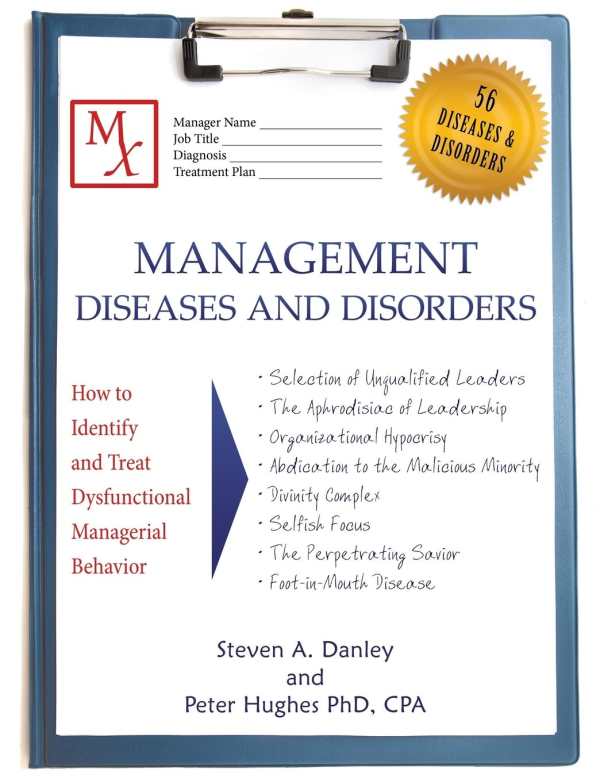Management Diseases and Disorders
How to Identify and Treat Dysfunctional Managerial Behavior
Danley and Hughes have crafted a business book that outshines others.
Management Diseases and Disorders by Steven Danley and Peter Hughes is a cleverly constructed, creative examination of modern-day business deficiencies. One look at the intriguing title makes it clear that businesses, and the people who manage them, are far from perfect. This executive management handbook disguised as a simulated medical manual encourages leaders to examine themselves and their organizations critically and objectively.
The intent of the authors—to collect, categorize, and describe the specific ailments that can afflict businesses—is compelling. Danley and Hughes, two organizational experts, manage to identify fifty-six individual “diseases and disorders” that can occur in a business setting. They are divided into two main categories: personality-based and culture- or system-based.
The book follows a format that mirrors a medical journal. Every “disorder” includes a definition, “healthy and normal function,” the condition’s causes, organizational risk, symptoms, “diagnostic analysis,” impact, prognosis, and treatment or cure. This approach makes it easy to compare and contrast one condition with another and to pick and choose the entries of greatest interest.
“Managerial Addiction” is one of the diseases in the “Personal Deficiencies” section of the book. The condition is defined as “the undeterred pursuit and resulting addiction to managerial enticements like fame, power, money, adulation, and territory.” Danley and Hughes proceed to describe this condition in understandable, direct text that carefully examines the potentially damaging impact on an organization. Included in the six bullets under “Treatment or Cure” are smart, actionable suggestions, such as “Ensure a sensible and methodical pace of progression for up-and-comers rather than moving people to the top before they are ready.” Other conditions, such as “Imposter Complex,” “The Perpetrating Savior,” and “Regulatory and Compliance Inefficiency” are equally engaging.
A nice touch that lends real-world context is the addition of a case study example for each condition. While some of the conditions seem to overlap, the authors maintain enough of a distinction among all of them to keep the content from becoming repetitive.
Identifying and classifying these “diseases and disorders” had to be a significant task, but even more impressive is the insight demonstrated by the authors in describing them and proposing appropriate “treatments.” Danley and Hughes are incredibly adept at uncovering the conditions themselves and then making them come alive in descriptive, meaningful terms.
The high quality of the writing is similar for every disease or disorder. Additionally, the book is well-formatted with lots of subheads, bullet points, and short paragraphs. The final comments offered by the authors are also interesting and perceptive.
Danley and Hughes have crafted a business book that outshines others. The text employs a concept that offers a distinctive and high-impact way to highlight universally applicable organizational weaknesses and put forward viable solutions.
Reviewed by
Barry Silverstein
Disclosure: This article is not an endorsement, but a review. The publisher of this book provided free copies of the book and paid a small fee to have their book reviewed by a professional reviewer. Foreword Reviews and Clarion Reviews make no guarantee that the publisher will receive a positive review. Foreword Magazine, Inc. is disclosing this in accordance with the Federal Trade Commission’s 16 CFR, Part 255.

